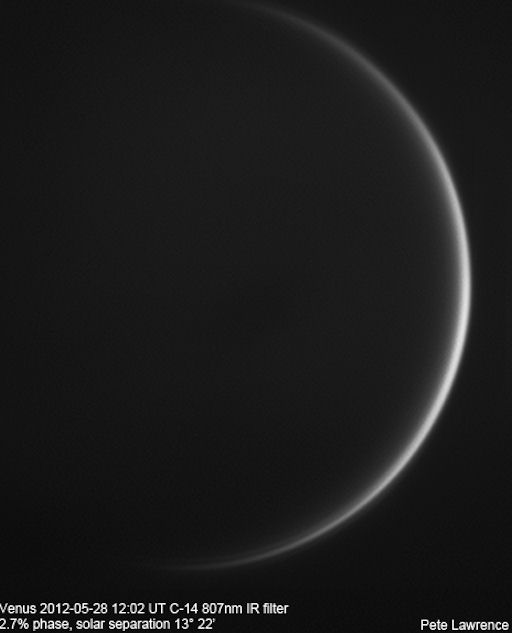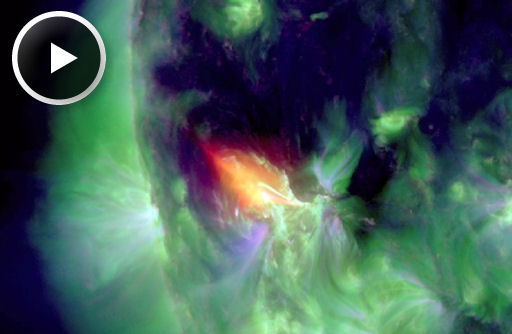It's a once in a lifetime event: the June 5th Transit of Venus across the sun. Watch the world wide webcast sponsored by the Coca-Cola Science Center and NASA. | | |
SMALL ASTEROID BUZZES EARTH: Newly-discovered asteroid 2012 KT42 is flying past Earth today (May 29th) only ~14,000 km above the planet's surface. This means 2012 KT42 will actually fly inside the Clark Belt of geosynchronous satellites. The 3- to 10-meter wide asteroid ranks # 6 on the top 20 list of closest-approachers to Earth. According to the asteroid's orbit, there is no danger of a collision. Even if it did hit, this space rock is too small to cause significant damage. It would likely disintegrate almost entirely in the atmosphere, peppering the ground below with relatively small meteorites. Flyby images: #1, #2.
VENUS SLENDERIZES: As Venus approaches the sun for a much-anticipated transit on June 5-6, the second planet is turning its night side toward Earth. Seen through a telescope, all that remains of Venus is a vanishingly-slender crescent:

Pete Lawrence of Selsey, UK, took the picture in broad daylight on May 28th: "This beautiful planet has just slipped below 2.7% phase on it's way to the historic transit on June 5/6. We had clear sunny weather today, so I was able to capture Venus in daylight conditions."
In words and a picture, he explains how he accomplished the daytime shot: "Sun shields were erected to shade the main telescope. In addition, the main tube was wrapped in aluminium foil in an attempt to keep it cool and prevent internal air currents from distorting the view. Note the proper solar filter--i.e. not foil!--covering the full aperture."
The crescent of Venus could soon become a ring. When Venus is less than few degrees away from the sun, the horns of the crescent soetimes reach around and touch, producing a complete annulus. The effect is caused by sunlight-scatteriing particles in upper layers of Venus's atmosphere. It is very difficult to observe, and often only black-belt astrophotographers are able to record the phenomenon.
Keep an eye on SpaceWeather's realtime photo gallery to see how Venus shape-shifts in the days ahead.
Space Weather Real Time Image Gallery
[Submit your photos] [NASA video: 2012 Transit of Venus]
AR1492 ERUPTS, CME TARGETS MARS: The magnetic canopy of sunspot AR1492 erupted on May 27th, producing a long-duration C3-class solar flare and hurling a coronal mass ejection (CME) toward Mars. NASA's Solar Dynamics Observatory recorded the explosion's extreme UV flash:

Note the shadowy wave billowing away from the blast site. That's the 'solar tsunami' so often associated with the ejection of CMEs.
Analysts at the Goddard Space Weather Lab say the CME from this blast will hit the Mars Science Lab spacecraft (containing Mars rover Curiosity) on May 31st at 0100 UT followed by Mars itself about 10 hours later. Earth could receive a glancing blow from the cloud on May 29th; more likely, though, it will completely miss.
Potentially Hazardous Asteroids (
PHAs) are space rocks larger than approximately 100m that can come closer to Earth than 0.05 AU. None of the known PHAs is on a collision course with our planet, although astronomers are finding
new ones all the time.
On May 29, 2012 there were 1293 potentially hazardous asteroids.
Notes: LD means "Lunar Distance." 1 LD = 384,401 km, the distance between Earth and the Moon. 1 LD also equals 0.00256 AU. MAG is the visual magnitude of the asteroid on the date of closest approach. | | The official U.S. government space weather bureau |
| | The first place to look for information about sundogs, pillars, rainbows and related phenomena. |
| | Researchers call it a "Hubble for the sun." SDO is the most advanced solar observatory ever. |
| | 3D views of the sun from NASA's Solar and Terrestrial Relations Observatory |
| | Realtime and archival images of the Sun from SOHO. |
| | from the NOAA Space Environment Center |
| | the underlying science of space weather |

